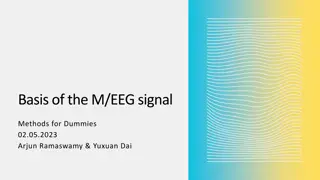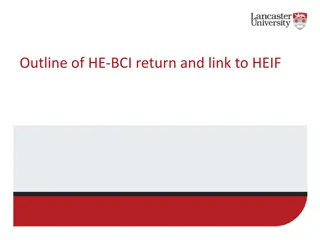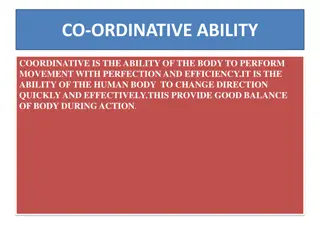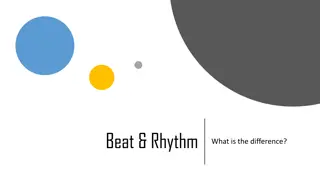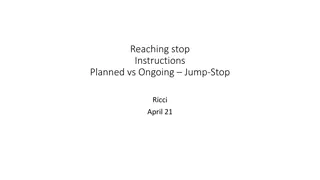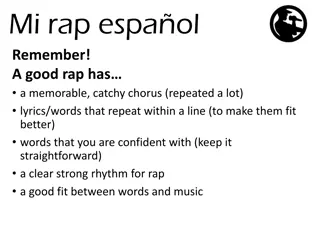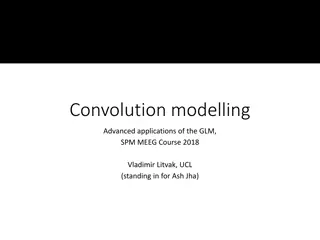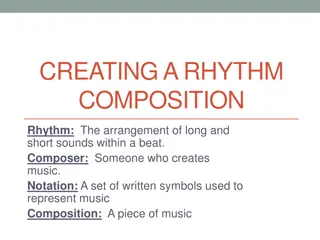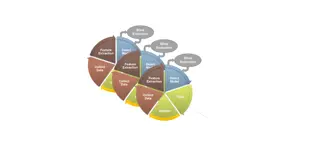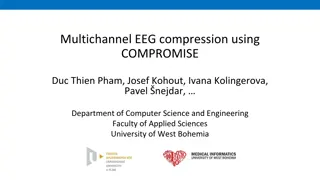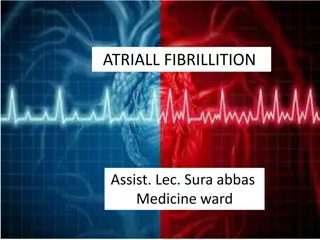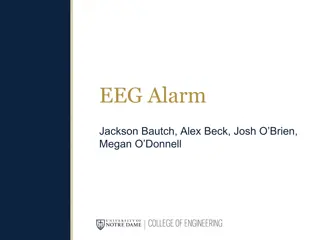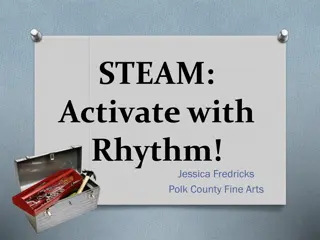EEG-Based BCI System for 2-D Cursor Control Combining Mu/Beta Rhythm and P300 Potential
Brain-computer interfaces (BCIs) offer a pathway to translate brain activities into computer control signals. This paper presents a novel approach for 2-D cursor control using EEG signals, combining the Mu/Beta rhythm and P300 potential. By simultaneously detecting two brain signals, P300 and motor imagery, users can control vertical and horizontal cursor movements efficiently in real-world applications. The proposed hybrid BCI system shows promising results for enhanced interfacing between users and machines.
Download Presentation

Please find below an Image/Link to download the presentation.
The content on the website is provided AS IS for your information and personal use only. It may not be sold, licensed, or shared on other websites without obtaining consent from the author. Download presentation by click this link. If you encounter any issues during the download, it is possible that the publisher has removed the file from their server.
E N D
Presentation Transcript
An EEG-Based BCI System for 2-D Cursor Control by Combining Mu/Beta Rhythm and P300 Potential Yuanqing Li et al. IEEE Trans. Biomedical Eng. (2010.10) Presenter : Younghak Shin GIST, Dept. of Information and Communication, INFONET Lab. 1 INFONET, GIST Nov 20, 2012 /27
Background P300 Motor imagery (Mu/Beta Rhythm) 2 INFONET, GIST Nov 20, 2012 /27
Introduction & Motivation Brain computer interface is a communication and control pathway to directly translate brain activities into computer control signals. An important issue in BCI research is cursor control: to map brain signals to movements of a cursor on a computer screen. Cursor control is a basic and necessary application in BCIs. In the EEG-based BCI field, most related studies were focused on 1- D cursor control using motor imagery feature. (our experiment) Multidimensional cursor control enables enhanced interfacing between the user and the machine (much wider range of applications) 3 INFONET, GIST Nov 20, 2012 /27
Introduction & Motivation The development of 2-D control BCI is impeded by the difficulty in obtaining two independent control signals from the noisy EEG data of poor spatial specificity. The first EEG-based 2-D cursor control BCI is remarkable [Wolpaw 2004]: two independent control signals could be derived from combinations of the rhythmic powers(mu and beta). However, the downside of this approach is the required intensive user training (some weeks or months). Also other forms of 2-D BCI were reported that adopted a discrete control paradigm using the steady-state visual evoked potential (SSVEP) and P300. 4 INFONET, GIST Nov 20, 2012 /27
Introduction & Motivation P300 and SSVEP based BCI cursor control system For each update of the position, the cursor takes only one of a few fixed directions (discrete). This leads to unsmooth, zigzag like moves of the cursor. 5 INFONET, GIST Nov 20, 2012 /27
Introduction & Motivation More efficient 2-D control is required for real world application This could be implemented through the combination of two independent control signal for vertical and horizontal movements In this paper, they propose a new paradigm for 2-D cursor control by simultaneously detecting two brain signals; P300 and motor imagery (hybrid BCIs) The user control the vertical movement by using a P300. At the same time, the user also use a motor imagery to control the horizontal movement. 6 INFONET, GIST Nov 20, 2012 /27
Introduction & Motivation The P300 allows to select one of the three states: moving upwards, moving downwards, or no vertical movement. The motor imagery translates motor imagery into a continuous value that determine the direction and the velocity of the horizontal movement. Through selecting the vertical movement state and manipulating the horizontal speed with direction, users will move the cursor along any direction in a self-paced manner. Since the neural mechanism of motor imagery differs largely from that of P300, the two signals can be independently controlled by the user. 7 INFONET, GIST Nov 20, 2012 /27
Method - Experimental Procedure To evaluate the proposed method, they conduct an online experiment involving six subjects. After a short calibration(training) session for subject-specific P300 and motor imagery modeling, the subjects undergo a few sessions of feedback training using the GUI, and subsequently perform cursor control tasks in test sessions. In particular, the feedback training emphasizes on learning of motor imagery control. 8 INFONET, GIST Nov 20, 2012 /27
Method - GUI and Control Mechanism The ball and the square, respectively, represent a cursor and a target. the GUI has a dimension of 1166 pixels 721pixels. In each trial, the initial cursor and target randomly appear inside a rectangular workspace. Eight flashing buttons are located at the side, which would generate P300 potentials when the user focus attention on one of them. The main objective for the arrangement of three up and down buttons is for user s convenient use. For example, if the cursor is now in the right-hand side, then the user can choose the up or down button located in the same side The horizontal movement of the cursor is controlled by motor imagery. 9 INFONET, GIST Nov 20, 2012 /27
Method - Test trial A trial begins when a target and a cursor appear. At 100 ms later, the eight buttons begin to flash alternately in a random order. Each button is intensified for 100 ms, while the time interval between two consecutive button flashes is 120 ms. The trial ends when the cursor hits the target or when the 60-s timeout limit occurs. The interval between two consecutive trials is 2 s. The cursor s position is updated every 200 ms; the user is able to control the cursor s movement at any time at will (self-paced) 10 INFONET, GIST Nov 20, 2012 /27
Method - Control of Vertical Movement Based on P300 Potential Let c(k) {1, 1, 0} represents the output: 1 for down, 1 for up, and 0 for stop (applied to vertical movement only). The vertical movement model: y(k + 1) = y(k) + c(k)v0 where y(k) represents the vertical position at the k-th update, at a fixed interval of 200 ms and v0 is a positive speed constant. If the output c(k) is 0, the cursor stops vertical movement; if the output is 1 or 1, the cursor moves up or down at a speed of 10 pixels every 200 ms. 11 INFONET, GIST Nov 20, 2012 /27
Method - Algorithm (vertical) 1. Feature extraction I. II. III. The obtained data vector is denoted as Pai,j,q , where i, j, and q represent the i th channel, the j th button associated with this flash, and the q th round, IV. Construct a feature vector corresponding to the j th button and the q th round by concatenating the vectors Pai,j,q from all channels, i.e., Fej,q = [Pa1,j,q , . . . ,Pa30,j,q ]. 30 channel EEG signals are filtered in the range of 0.1 20 Hz Extract a segment from 0 to 600 ms after a button flashes 2. Train a support vector machine (SVM) classifier. I. Using the feature vectors of the training dataset {Fej,q, j = 1, . . . , 8; q =1, . . . , 64} and their corresponding labels, we train an SVM classifier. If the subject is focusing on the j th button in the q th round, then the label of Fej,q is 1 (p300 presence), while the labels of Feu,q (u j) is 1 (p300 absence). II. 12 INFONET, GIST Nov 20, 2012 /27
Method 3. P300 detection with SVM scores I. II. III. P300 detection requires discriminating between non-P300(idle state) and P300 rounds self-paced IV. The detection of P300 is accomplished by a threshold mechanism - Calculate the sum of SVM scores for each button obtained from l accumulated rounds - Find maximum and the second maximum of the eight summed scores For the l th round, we extract feature vectors Fej,l (j = 1, . . . , 8) Applying the trained SVM to Fej,l, we obtain eight scores denoted as sj,l - - where the j1 th button is obviously different from the j0 th button define a threshold condition : - where the threshold 0 is a predefined positive constant, and is empirically set at 0.3 If the threshold condition is satisfied, then the system makes a decision that P300 potential occurs at the j0 th button - 13 INFONET, GIST Nov 20, 2012 /27
Method 4. Movement Decision I. II. when P300 is detected for the l th round at the j0 button if the j0 button is one of the three up buttons, set c(k) = 1 (the cursor will go up); III. if the j0 button is one of the two stop buttons, set c(k) = 0 (the cursor will have no vertical movement). IV. If P300 is not detected for the l th round, i.e., the threshold condition is not satisfied, V. then the system does not change the direction of the vertical movement of the cursor, i.e., c(k) = c(k 1). 14 INFONET, GIST Nov 20, 2012 /27
Method - Control of the Horizontal Movement Through Motor Imagery The horizontal movement model: where k represents the k th update of the cursor position, x(k) is the horizontal coordinate of the cursor, f(k) is the continuous output (score) of the SVM classifier, and a and b are two constants. They introduce delays into the control model to make the cursor move smoothly The score f(k) is generated by an SVM classifier at every 200 ms. pre-processing steps spatial filtering with common average reference (CAR) bandpass filtering in specific mu rhythm band (8 13 Hz) spatial filtering based on a common spatial pattern (CSP) matrix W. The feature vector is fed into an SVM classifier that is trained using the training data to separate the two classes of feature vectors 15 INFONET, GIST Nov 20, 2012 /27
Method In motor imagery, the cursor shall not move, if the user is in idle state. This is accomplished by the introduction of the two parameters: a and b An EEG dataset is collected when the user is in idle state. This dataset contains N time segments of 200 ms (N = 600), i.e., lasts 2 min. They calculate the SVM scores f(1), . . . , f(N). Set Then we calculate a and b as The parameter h is used for adjusting the velocity of the cursor. h is fixed to 8 for all the subjects. Considering the model : and the parameter setting of a and b, the average horizontal movement during the idle state Is close to zero. Thus, the cursor almost does not change its horizontal position, if the subject is in the idle state. This has been demonstrated during the online experiments. 1 N ( ) 1 N + ( 1) ( ) x k x k = 1 k 16 INFONET, GIST Nov 20, 2012 /27
Method Combining the algorithms for vertical and horizontal movement control, they obtain the algorithm for 2-D cursor control [Diagram of the algorithm for 2-D cursor control] The horizontal movement control based on motor imagery and the vertical movement control based on P300 are performed simultaneously 17 INFONET, GIST Nov 20, 2012 /27
results we can find out that the accuracy rates of all the six subjects are satisfactory. However, the control time of each trial was not short (about 28 s in average). The relative small size of the cursor and the target. The ratios of the size of the cursor, target, and the workspace are fixed to be 0.00084:0.003:1. Triggering and effectively detecting P300 are time consuming to some degree (repeated round). 18 INFONET, GIST Nov 20, 2012 /27
Data Analysis and Discussions For efficient 2-D control, the two control signals need to be as independent as possible. First, analyze the data collected from online experiment and assess the independence between the two control signals by correlation method. There exist horizontal and vertical control variables with values f(k), c(k) Here, f(k) is an SVM score from motor imagery, while c(k) with value of 1, 1, or 0 is determined by the button The button at which P300 occurs is determined by ssj0(k), the maximum of 8 SVM scores corresponding to the eight buttons. Since ssj0(k) is generally positive, they let c(k)ssj0(k) to be a new vertical control variable with signs and amplitude. For each trial, they also define two position variables representing the relative position of the cursor and the target = = ( ) x k , ( ) y k x x y y t c t c where t and c means the target and the cursor (at its initial position) 19 INFONET, GIST Nov 20, 2012 /27
Data Analysis and Discussions Calculate the correlation coefficients for each pair of control variable (f(k) or c(k)ssj0 (k)) and position variable ( ?(? or ?(? ) and the correlation coefficient for the two control variables. From the result, each control variable correlates strongly with its own dimension of target cursor position and does not correlate with the other variables dimension and also does not correlate with the other variable. Hence, such results support the independence of the horizontal and vertical control variables. 20 INFONET, GIST Nov 20, 2012 /27
Data Analysis and Discussions Next, they present their data analysis results to show that the subjects truly used P300 and motor imagery in the 2-D cursor control. P300 detection is mainly based on those channels located in the occipital and parietal areas rather than the frontal area (considered EOG). we can see P300 potentials elicited by the two chosen buttons and no P300 potentials elicited by other buttons. 21 INFONET, GIST Nov 20, 2012 /27
Data Analysis and Discussions They also plot the topographies of CSP filters and the power spectra of two channels of raw EEG signals calculated based on the training dataset. CSP filters (the first and the last rows of W) are displayed which are easily related to the motor imageries of right and left hands The discriminability of the brain signals corresponding to the right and left hands is demonstrated. 22 INFONET, GIST Nov 20, 2012 /27
TWO SUPPLEMENTARY EXPERIMENTS In order to show the average trajectory of the cursor based on desired movements, the trajectories of the cursor starting at the center of the GUI and moving to one of the four fixed targets at four corners Left: trajectories of the cursor obtained in 80 trials. Right: four average trajectories The hit rate and the average control time are 97.5% and 24.7 s The trajectories of single trials and the average trajectories for four target positions are quite smooth. 23 INFONET, GIST Nov 20, 2012 /27
TWO SUPPLEMENTARY EXPERIMENTS Second experiment, to show P300 and motor imagery control work simultaneously. fix two targets, and fix the initial position of the cursor at the middle left In each trial, the subject needs to move the cursor to hit these two targets sequentially without stop. (two classes of trial) first class, the subject move the cursor to first hit the target at the middle of upper part and then hit the target at down-right corner second class, the subject move the cursor to first hit the target at down right corner and then hit the target at the middle of upper part. 24 INFONET, GIST Nov 20, 2012 /27
TWO SUPPLEMENTARY EXPERIMENTS 80 trials were collected for two classes of trials (40 trials for each class) The hit rate and the average control time are 98.75% and 49.1 s for each trial, the direction of vertical movement of the cursor is changed while the cursor simultaneously moves to the right. Thus, the cursor can be simultaneously controlled (no zigzag) by the two control signals of P300 and motor imagery. 25 INFONET, GIST Nov 20, 2012 /27
Conclusion They have presented a new BCI and its implementation for 2-D cursor-control by combining the P300 potential and motor imagery. Two independent signals have been obtained for controlling two degrees of movements of a cursor simultaneously. Through an online experiment involving six subjects performed 2-D cursor control tasks. The six subjects successfully carried out 2-D cursor control with satisfactory accuracies (>80%). 26 INFONET, GIST Nov 20, 2012 /27
Thank you 27 INFONET, GIST Nov 20, 2012 /27




